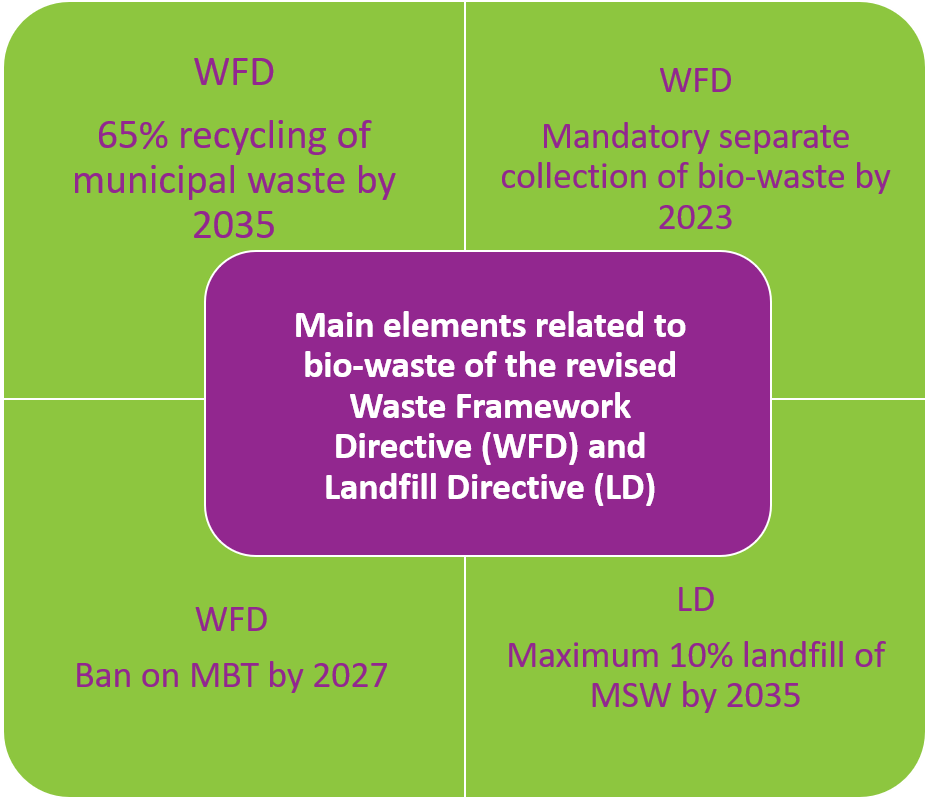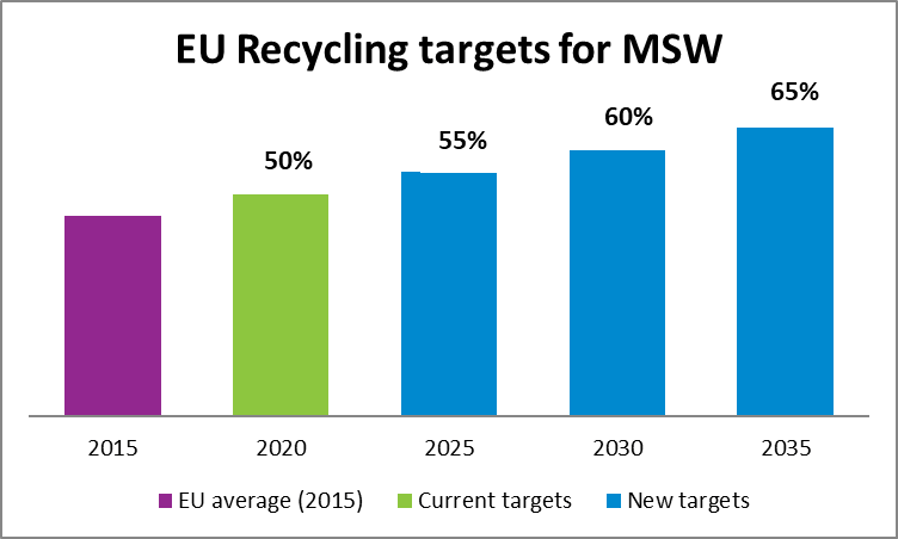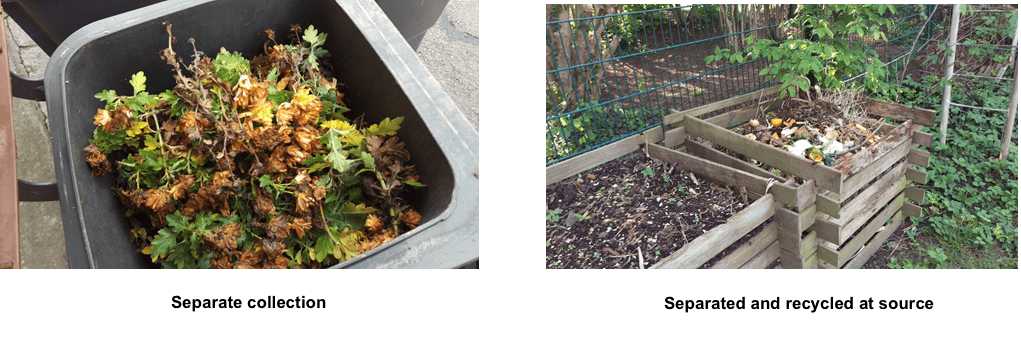With the adopted Circular Economy Package in 2018 the EU has paved the way for better bio-waste management in Europe and as well for placing recycled bio-waste materials on the European Market as products.
The main objectives of the EU Circular Economy are
- To reduce the waste production in Europe,
- To promote recycling,
- To save primary resources, and
- To establish markets for secondary products.
With the adoption of the waste legislative revisions and the revision of the EU Fertiliser Regulation (EU) 2019/1009 in 2019 the legislative frame for achieving these objectives is set.
I. Main Targets of the Waste Legislative Revisions
II. Compulsary Separate Bio-Waste Collection
 I. Main Targets of the Waste Legislative Revision
I. Main Targets of the Waste Legislative Revision
The main elements with relevance for improving bio-waste managing in Europe are
- The overall recycling target of municipal waste of 65 % by 2035,
- The mandatory separate collection of bio-waste by 2023,
- The exclusion to account mechanical biological treatment of municipal waste for recycling by 2027, and
- The 10 % reduction target of municipal solid waste being landfilled by 2035.
Besides the final recycling target of municipal solid waste, intermediate targets with 55 % by 2025 and 60 % by 2030 were set.
 Recycling Targets
Recycling Targets
For achieving the overall recycling target of 65 % of municipal waste by 2035 and to facilitate high quality recycling separate collection and biological treatment of bio-waste have to be introduced across Europe.
With regard to bio-waste only separate collected biowaste or separated at source can be accounted as recycled from 1st January 2027. This will give member states enough time to switch from mixed waste treatment to high quality recycling of bio-waste through composting or anaerobic digestion of separately collected bio-waste.
Calculation of Recycling Targets
For the calculation of the recycling targets the input material that enters aerobic or anaerobic treatment may be counted where it generates compost, digestate or other output with similar quantity of recycled content in relation to input, and which is used as recycled product, material or substance. Where the output is used on land, it may only be considered as recycled if resulting in agriculture or ecological improvement (WFD §11a (4a)).
End-of-waste materials to be used as fuels or other means to generate energy, be incinerated, backfilled or landfilled, cannot be counted towards the recycling targets (WFD §11a (4b)).
Calculation Method
On 20 July 2019 the EU has published the implementation decision on the calculation of recycling targets. This implementation decision includes the calculation method for the recycling targets, and it defines the calculation point for recycling for different materials in Annex I.
Annex II is of relevance for bio-waste, as it describes the methodology for calculating municipal bio-waste separated and recycled at source.
According to the implementation decision the calculation point is defined as the point where municipal waste materials enter the recycling operation whereby waste is reprocessed into products, materials or substances that are not waste or the point where waste materials cease to be waste as a result of a preparatory operation before being reprocessed.
Municipal bio-waste separated and recycled at source means bio-waste that is recycled at the place where it is produced by the person who produce it. That means separately collected bio-waste as well as home-composted may be taken into account for recycling.
Further Information: Study to Support the Implementation of Reporting Obligations Resulting from the New Waste Legislation Adopted in 2018 (EU, 2019).
II. Compulsary Separate Bio-Waste Collection
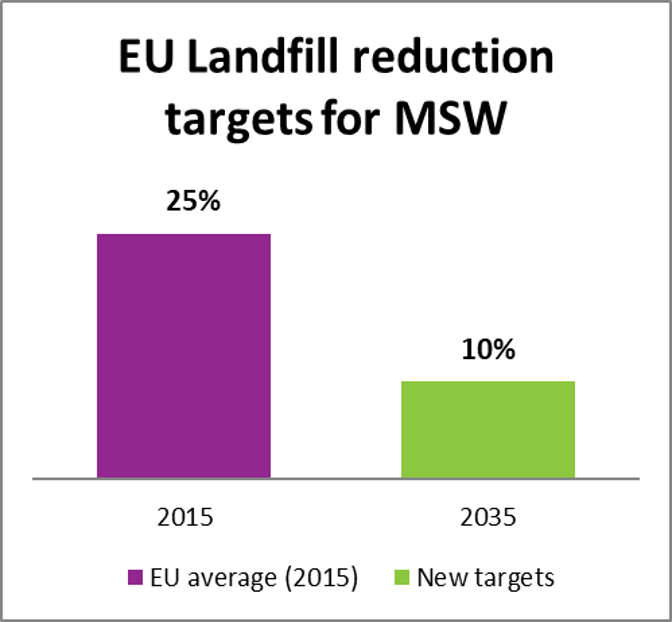 Of particular relevance to the future development of bio-waste treatment in Europe are the proposed changes to the EU Landfill Directive (EU) 2018/850, namely:
Of particular relevance to the future development of bio-waste treatment in Europe are the proposed changes to the EU Landfill Directive (EU) 2018/850, namely:
- to reduce the landfilling of municipal waste to 10% by 2030, and
- a general ban on the landfilling of separately collected waste.
As bio-waste is the largest fraction of Europe’s municipal waste stream (comprising, on average, 34% by weight), the 10% landfill target can only be met through sustainable bio-waste management, including composting and anaerobic digestion.
Separate Collection as Prerequisite for High-Quality Recycling
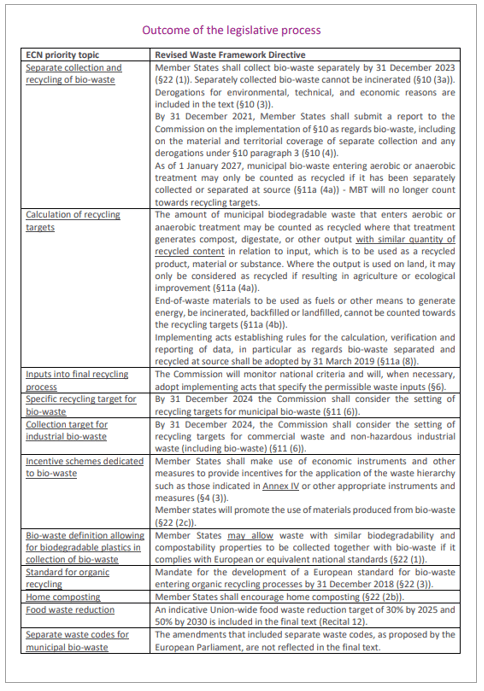 The prohibition of landfilling and incineration of separately collected waste needs to be viewed in the context of the obligation for separate collection or separated at sources as set in the Waste Framework Directive (EU) 2018/851. Notably, the separate collection of bio-waste is a prerequisite to ensure compliance with quality standards for compost and digestate, as well as contributing at source required to introduce appropriate incentives to achieve waste prevention and recycling targets. The introduction and increase of landfill and incineration taxes are intended to contribute to the recycling of waste in accordance with the waste hierarchy.
The prohibition of landfilling and incineration of separately collected waste needs to be viewed in the context of the obligation for separate collection or separated at sources as set in the Waste Framework Directive (EU) 2018/851. Notably, the separate collection of bio-waste is a prerequisite to ensure compliance with quality standards for compost and digestate, as well as contributing at source required to introduce appropriate incentives to achieve waste prevention and recycling targets. The introduction and increase of landfill and incineration taxes are intended to contribute to the recycling of waste in accordance with the waste hierarchy.
According to the Waste Framework Directive derogations from the separate collection of bio-waste will be only accepted based on environmental, technical and economic reasons.
The member states have to report the material and territorial coverage of separate collection and any derogations towards the EU.
Further information is available for download:
Guidance for separate collection of municipal waste (EU, 2020)
ECN Factsheet on the outcome of the Waste Legislative Revisions (2018)

